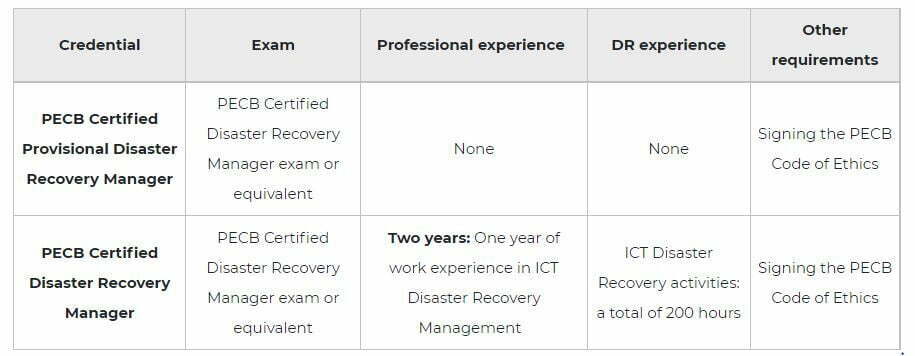TRAINING DAYS
3
CPD CERTIFICATION
21 Credits
EXAM DURATION
3 Hours
EXAM RETAKE POSSIBLE?
Yes. Free one more exam in 12 months
WHAT IS INCLUDED?
Training, PECB exam and certification
Why Should You Attend?
Disaster Recovery Manager training enables you to acquire the necessary knowledge to support an organization in implementing, maintaining and managing an ongoing Disaster Recovery Plan. During this training course, you will also gain a thorough understanding of best practices in Disaster Recovery.
After understanding all the necessary concepts of Disaster Recovery processes, you can sit for the exam and apply for a “PECB Certified Disaster Recovery Manager” credential. By holding a PECB Disaster Recovery Manager Certificate, you will be able to demonstrate that you have the practical knowledge and professional capabilities to implement and manage Disaster Recovery processes in an organization.
Who Should Attend?
Learning objectives
This training course will help you:
Educational approach
Prerequisites
A fundamental understanding of Disaster Recovery Services and comprehensive knowledge of management principles.
Course Agenda
Day 1: Introduction to Disaster Recovery and initiation of a DR Plan
Day 2: Risk Mitigation Strategies and Disaster Recovery Planning
Day 3: Disaster Recovery Outsourced services, Response and Activation, Training and Testing and Certification Exam
Examination
The “PECB Certified Disaster Recovery Manager” exam fully meets the requirements of the PECB Examination and Certification Programme (ECP). The exam covers the following competency domains:
Domain 1: Fundamental principles and concepts of a Disaster Recovery Plan
Domain 2: Disaster Recovery plan development
Domain 3: Recovery facilities and outsourced services capability
Domain 4: Testing and Maintenance of a disaster recovery plan
General Information
1. Certification fees are included on the exam price
2. Training material containing over 350 pages of information and practical examples will be distributed
3. An attestation of course completion worth 21 CPD (Continuing Professional Development) credits will be issued to the participants who have attended the training course.
4. In case of exam failure, you can retake the exam within 12 months for free
Certification
After successfully completing the exam, you can apply for the credentials shown on the table below. You will receive a certificate once you comply with all the requirements related to the selected credential.
The requirements for PECB Disaster Recovery Manager Certifications are:

To be considered valid, these disaster recovery activities should follow best implementation and management practices and include the following:
1. Establishing a Disaster Recovery Plan
2. Identifying assets, threats, existing controls, vulnerabilities and consequences (impacts)
3. Assessing consequences and incident likelihood
4. Evaluating Disaster Recovery strategies
5. Selecting and implementing Disaster Recovery strategies
6. Performing a review of a Disaster Recovery Plan

